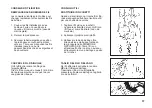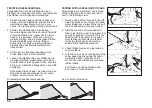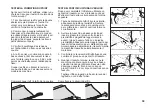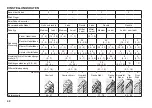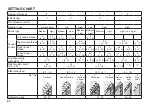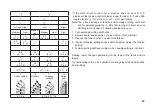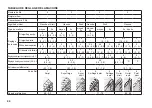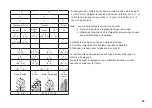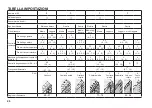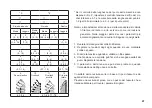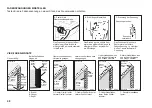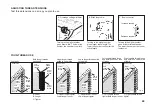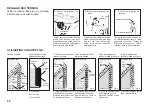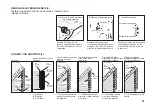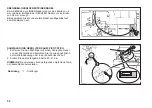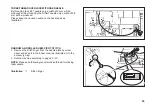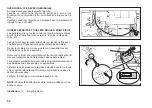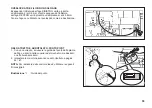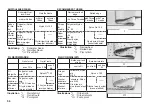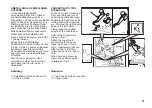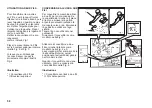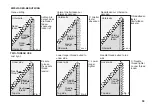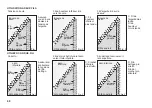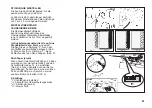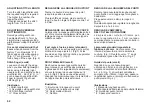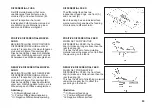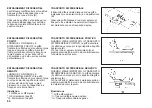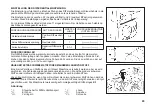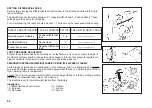
51
REGOLARE LA TENSIONE DEI FILI
Testare le tensioni dei fili su un pezzetto di tessuto che si
intende utilizzare.
UTILIZZO CON QUATTRO FILI
Corretto.
Fig. 2
Fig. 3
Fig. 4
Fig. 5
Filo del crochet superiore
tirato verso il lato
inferiore.
Entrambi i fili dei crochet
sporgono.
Filo del crochet inferiore
tirato verso il lato
superiore.
Filo dell’ago sinistro
allentato e visibile sul lato
inferiore del tessuto.
Filo dell’ago destro
allentato e visibile sul lato
inferiore del tessuto.
C: Crochet superiore più
stretto Crochet inferiore
più allentato
A: Più ampio
B: Più lungo
C: Più stretto
C: Crochet superiore più
allentato Crochet inferiore
più stretto
C: Filo dell’ago sinistro
più stretto Entrambi i
crochet più allentati
C: Filo dell’ago destro più
stretto
Lato inferiore
Lato superiore
Filo
del crochet
superiore
Filo
del crochet
inferiore
Filo
dell’ago
sinistro
Filo
dell’ago
destro
Lato inferiore
Lato superiore
Filo
del crochet
superiore
Filo
del crochet
inferiore
Lato inferiore
Lato superiore
Lato inferiore
Lato superiore
Filo
del crochet
superiore
Filo
del crochet
inferiore
Filo
dell’ago
sinistro
Filo
dell’ago
destro
B. Manopola lunghezza punto
Passare ai numeri più alti
fornisce una lunghezza del punto
maggiore. Più il numero è basso,
minore è la lunghezza del punto.
Passare ai numeri più alti
fornisce un’ampiezza maggiore.
Più il numero è basso, minore è
l’ampiezza.
Fig. 1
Lato inferiore
Lato superiore
Filo
del crochet
superiore
Filo
del crochet
inferiore
Filo
dell’ago
sinistro
Filo
dell’ago
destro
C. Controllo tensione
Passare ai numeri più alti fornisce
una maggiore tensione del filo.
Più il numero è basso, minore è
la tensione.
ADJUSTING THREAD TENSIONS
Test thread tensions on a scrap you plan to use.
FOUR-THREAD USE
Just right.
Fig. 2
Fig. 3
Fig. 4
Fig. 5
Upper looper thread pulled
to under side.
Both looper threads hanged
Lower looper thread pulled
to top side.
Left needle thread loose
and visible on under side of
fabric.
Right needle thread loose
and visible on under side of
fabric.
C: Upper looper tighter
Lower looper looser
A: Wider
B: Longer
C: Tighter
C: Upper looper looser
Lower looper tighter
C: Left needle thread tighter
Both looper looser
C : R i g h t n e e d l e t h r e a d
tighter
Under side
Top side
Upper
looper
thread
Lower
looper
thread
Left
needle
thread
Right
needle
thread
Under side
Top side
Upper
looper
thread
Lower
looper
thread
Under side
Top side
Under side
Top side
Upper
looper
thread
Lower
looper
thread
Left
needle
thread
Right
needle
thread
A. Overedge cutting width dial
B. Stitch length dial
Turning to the higher number gives
longer stitch length. The lower the
number, the shorter the stitch length.
Turning to the higher number gives
wider width. The lower the number,
the narrower the width.
Fig. 1
Under side
Top side
Upper
looper
thread
Lower
looper
thread
Left
needle
thread
Right
needle
thread
C. Tension control
Turning to the higher number gives a
tighter thread tension. The lower the
number, the looser the tension.
longer
shorter
narrower
wider
Decrease tension
Increase tension
ADJUSTING THREAD TENSIONS
Test thread tensions on a scrap you plan to use.
FOUR-THREAD USE
Just right.
Fig. 2
Fig. 3
Fig. 4
Fig. 5
Upper looper thread pulled
to under side.
Both looper threads hanged
Lower looper thread pulled
to top side.
Left needle thread loose
and visible on under side of
fabric.
Right needle thread loose
and visible on under side of
fabric.
C: Upper looper tighter
Lower looper looser
A: Wider
B: Longer
C: Tighter
C: Upper looper looser
Lower looper tighter
C: Left needle thread tighter
Both looper looser
C : R i g h t n e e d l e t h r e a d
tighter
Under side
Top side
Upper
looper
thread
Lower
looper
thread
Left
needle
thread
Right
needle
thread
Under side
Top side
Upper
looper
thread
Lower
looper
thread
Under side
Top side
Under side
Top side
Upper
looper
thread
Lower
looper
thread
Left
needle
thread
Right
needle
thread
A. Overedge cutting width dial
B. Stitch length dial
Turning to the higher number gives
longer stitch length. The lower the
number, the shorter the stitch length.
Turning to the higher number gives
wider width. The lower the number,
the narrower the width.
Fig. 1
Under side
Top side
Upper
looper
thread
Lower
looper
thread
Left
needle
thread
Right
needle
thread
C. Tension control
Turning to the higher number gives a
tighter thread tension. The lower the
number, the looser the tension.
longer
shorter
narrower
wider
Decrease tension
Increase tension
più lungo
più corto
più stretto
più ampio
ADJUSTING THREAD TENSIONS
Test thread tensions on a scrap you plan to use.
FOUR-THREAD USE
Just right.
Fig. 2
Fig. 3
Fig. 4
Fig. 5
Upper looper thread pulled
to under side.
Both looper threads hanged
Lower looper thread pulled
to top side.
Left needle thread loose
and visible on under side of
fabric.
Right needle thread loose
and visible on under side of
fabric.
C: Upper looper tighter
Lower looper looser
A: Wider
B: Longer
C: Tighter
C: Upper looper looser
Lower looper tighter
C: Left needle thread tighter
Both looper looser
C : R i g h t n e e d l e t h r e a d
tighter
Under side
Top side
Upper
looper
thread
Lower
looper
thread
Left
needle
thread
Right
needle
thread
Under side
Top side
Upper
looper
thread
Lower
looper
thread
Under side
Top side
Under side
Top side
Upper
looper
thread
Lower
looper
thread
Left
needle
thread
Right
needle
thread
A. Overedge cutting width dial
B. Stitch length dial
Turning to the higher number gives
longer stitch length. The lower the
number, the shorter the stitch length.
Turning to the higher number gives
wider width. The lower the number,
the narrower the width.
Fig. 1
Under side
Top side
Upper
looper
thread
Lower
looper
thread
Left
needle
thread
Right
needle
thread
C. Tension control
Turning to the higher number gives a
tighter thread tension. The lower the
number, the looser the tension.
longer
shorter
narrower
wider
Decrease tension
Increase tension
Diminuire la tensione
aumentare la tensione
A. Manopola dell’ampiezza
del coltello rifilatore

